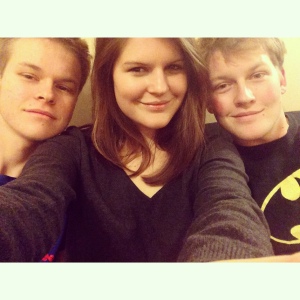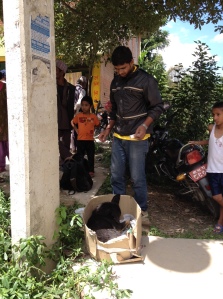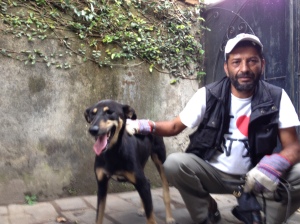@tangledjourneys on npr.org.
Category Archives: kathmandu valley

Another Year — another Christmas — Half way around the world

Madeline and Lucas bonding with the “tourist” Sadhus at Pashupatinath, kathmandu. © Donatellal Lorch
Winter has come to the Kathmandu Valley, with what the weather people here say is an unexpected cold snap. But after a year and a half living here, the unexpected is really the new normal. The high mountains have got more than five feet of snow so far this winter, stranding trekkers (rash enough to trek in December). Planes aren’t flying, and motorists in the far East, North and West of Nepal have been stranded for several days on snow-bound roads. And no, there aren’t any warm places to stop for a snack, and there are no nearby motels.
Meanwhile, in the Kathmandu Valley, it’s raining, which means temperatures are dipping to nearly freezing. There is no heat in the houses, and so we wear long underwear, multiple shirts and sweaters, down-filled jackets and fleece hats—inside the house–and sit very close to the fireplace and go to bed with hot water bottles right after dinner. I’ve broken down and bought our Rhodesian Ridgeback, Biko, a winter jacket to help him stop shivering.
As part of my tiny effort at reducing black carbon emissions – Kathmandu ranks as one of the world’s most polluted capitals – I try never to use our diesel generator – which is challenging in a city that in the dry winter months provides its denizens with only about six hours of electricity a day. But we are lucky to be in 2015 as in another few years, if Nepal cannot harness its massive hydropower potential, the valley’s rapidly growing population (4 million now and estimated to reach 15 million by 2045) will consider power grid electricity a rarity.
Kathmandu was originally home to our nine-year-old son, Lucas, Biko and myself—John, my husband and Lucas’s father, spends most of his time in Dhaka, where he works. Here in the valley, we seem recently to have added an adopted family of stray dogs that live outside our gate and grows each week as I deliver daily bowls of steaming rice and left-over meat in the hope that it will help the dogs cope with the nighttime cold.
Living here has been a godsend for me. I write and explore, both physically and mentally. The Kathmandu Valley is a gem of ancient art and living religions that date back to the early centuries of the common era. It has taken me over a year to begin an acquaintance with the dizzying complexities of Nepali and Newar cultures (the Newar were the valley’s original inhabitants). We live just up the road from Khokana, one of the oldest Newari towns in the valley, a place where medieval traditions continue: stables in the ground floor, butchering in the street, morning bathing on the doorstep with a pitcher of water, and lots of sidewalk and street-side activities like rice drying and wool carding on an ancient spinning wheel. I love my weekly runs through Khokana and the neighboring amphitheater of fields that alternate summer rice paddies with winter wheat and potatoes, with many of the villagers walking the paths out into the fields in the mornings to attend to their crops. And where else in the world can one live these days where there is not just one Maoist party, but three Maoist splinter parties fighting one another for supremacy?
Lucas, who before spoke English with a Swahili accent when we lived in Kenay, now has a Nepali lilt, with essential Britishisms such as “dustbin” (rarely seen outside his school) and “tipper truck” (increasingly the most popular and overloaded vehicle in the Valley as road and building construction booms). He is keen on becoming a fighter pilot as well as a Marine Corps engineer. With limited television, he now is addicted to the New York Times videos and to re-runs of Top Gear viewed on my Ipad. Internet videos about aircraft carriers of various kinds are also extremely popular on cold winter days.
John lives in Dhaka, working a grueling schedule in Bangladesh and commuting to his two other World Bank countries Nepal and Bhutan, with side trips to Delhi, Dubai and Washington D.C. Dhaka is one of the few capital cities even more polluted than Kathmandu or Delhi. It is not an ideal family life, but we have worked out a modus vivendi and structure our time together by using Lucas’ school term breaks as a chance to visit the region. In the past year or so, we have been able to visit Vietnam, Cambodia and Malaysia. John lives mostly on planes and even though his commute from Dhaka should in theory be only 1hr10 mins, it has been as long as 11 hours due to weather and technical delays. Kathmandu winter fog, further weighed down by heavy pollution, can close down airspace for hours.
Our Christmas gift to the family is that all six of us will converge from four countries and two continents—all now in winter– somewhere warm. This time, because of the logistics of moving the kids from half way around the world, we are meeting in Thailand. Raising kids while living overseas has recently meant for us longer times apart, as they hit their upper teens and head back to North America for schooling. Interestingly, we haven’t had a family argument in over three years. We speak more about “missing” rather than “wanting.” We laugh more. We make a point of having holidays together and then of connecting over long dinners. The kids have made sure we are geared up to communicate: through FaceTime, Skype, Whatsapp, email and even the traditional landline.
Alex, now 17 and hitting 6 feet, is about to finish high school and has applied to a number of colleges without asking for parental advice or assistance (except for filling out financial forms). From the extended family that sees him on long weekends, we understand that he is incredibly helpful cooking and cleaning. He remains an avid reader of Kant, Joyce, Woolf, Shakespeare and other writer-philosophers as well as the captain of his school’s Ultimate Frisbee team. This summer he showed himself an adept stunt diver, hooking his finger as he leapt through a hoolahoop into a Catskill pond and breaking his writing hand. All this was exquisitely timed, done on a Sunday the day before we headed back to Kathmandu. Three doctors, three casts, two countries and one week later, he was happily teaching Ultimate Frisbee to Nepali school kids with his left hand.
Nico, 20, is a junior in Physics and Philosophy at University of Toronto where he frequently ponders the greater meaning of life, a mental activity that entails long calls with John about the reason for man’s existence. I’d like to say that he chats with me about Quantum Physics but there are those that know that I barely passed high school physics and chemistry. Though he still does not have a Canadian driver’s license (his Kenyan one is unusable outside of East Africa), he has a boat piloting license and does a pilot and tour-guide double on Lake Eerie.
The oldest, Madeline, 22, studies Political Science and will graduate from the University of Toronto in the spring of 2015, with some trepidation about what will happen next. (I am sure that many of you have been there—I certainly have!) Madeline and I are the outliers in the family, as we don’t like Maths or science and enjoy the occasional People magazine. Mado is also the one who keeps the family together. With an unfailing self-deprecating humor, she makes sure she stays in touch with everyone on a regular basis. John, Lucas and I are trying to convince her to come to Nepal for a year. Who wouldn’t want to drive on death-defying roads, live without heat in winter, get bitten by leeches during the monsoons, and wake to the rattling bells that summon Shiva at 5:15 in the morning?
The magic of Nepal works in mysterious ways. Even the calendar overwhelms. There are 50 national holidays a year (I believe including Christmas) and more than a handful of New Years celebrations. If Madeline comes, she will have a lot of time off. Nothing is ordinary here. Nothing is what it seems.

The wisdom of a Nepali street dog
I had noticed her only in passing. On any given day there can be as many as 10 stray dogs moving up and down a 40-meter stretch of my street but I usually just pay attention to the two trouble makers that try to intimidate my Rhodesian Ridgeback when I take him out for a walk. The others either sit and watch or completely ignore our temporary presence.
Recently, a local crowd caught my attention, hovering over a dog lying and whimpering in an open sewage ditch, unable to move. A car had hit her, I was told, and she was incapable of walking or standing up.
Living in Kathmandu, an interaction with a stray dog is inevitable. There are, after all, more than 20,000 of them in the Valley’s tri-city area. When I first moved here a year ago, I lumped them all together into one large category: destitute, miserably hungry, unloved, unhappy and most critically, unvaccinated and un-neutered. Rabies is present throughout Nepal and Lucas, my nine-year-old son, knows never to reach out and pet a stray dog. Nepalis in general coexist with the strays, feeding them scraps, letting them hang out on their stoops, but the dogs are not family pets and the Nepalis do not care for them. On the dark side, I’ve seen dogs kicked and abused. I’ve seen little kids garrot a puppy and drag him around for fun. Some dogs, starving or maimed, grovel for leftovers from the stronger strays.
My Nepali neighbors hovered over the dog and attempted to feed and give her water, but she was in pain and intensely afraid. In Kathmandu, injured stray dogs are left to their fate, even if it means days of suffering. But I couldn’t walk away. At the same time, I was hesitant to interfere. In the back of my head I was replaying a line that my producer at NBC News would tell me regularly: “Dony, you can’t play God.”
Perhaps, I reasoned, I could make her death more peaceful if in fact she was badly injured. I couldn’t move her so I called the local mobile vet. Though Kathmandu is Nepal’s largest city, it is home to all types of farm animals, and vets also treat cows, buffalo, goats, sheep and elephants. After some time, two young men arrived on a motorcycle, pulled out a syringe and anesthetized the dog. They packed her in a cardboard crate, placed her between them on the bike and drove off to their roadside two-room clinic to X-ray the injury. I followed in my car.
 The dog had only tissue damage, but she needed a week of daily steroid, antibiotic and pain killer shots. This meant keeping her virtually immobile in the vet’s small cage, recovering for a week. If she was then immediately released back on the street, her chances of survival were slim. By then, it had become clear to me that I had inherited a stray and its hospital bill. She had also at some point been blinded by a stick or rod in her left eye, so before I changed my mind, I added in drops for the infected eye as well as rabies, distemper and paro-virus shots. Lucas named her Rexi. The Nepalis, having some difficulty in pronouncing Rexi, renamed her Raksi – after the local moonshine.
The dog had only tissue damage, but she needed a week of daily steroid, antibiotic and pain killer shots. This meant keeping her virtually immobile in the vet’s small cage, recovering for a week. If she was then immediately released back on the street, her chances of survival were slim. By then, it had become clear to me that I had inherited a stray and its hospital bill. She had also at some point been blinded by a stick or rod in her left eye, so before I changed my mind, I added in drops for the infected eye as well as rabies, distemper and paro-virus shots. Lucas named her Rexi. The Nepalis, having some difficulty in pronouncing Rexi, renamed her Raksi – after the local moonshine.
For the past year, in my morning runs and commutes to school, I have studied the multi-layered social interactions and relationships between Kathmandu canines and the world of humans. The Nepalis who have dogs as pets (often white, furiously yapping, furry Spitzes) keep them indoors or on their rooftops. Some people tie their guard dogs on such short chains outside their houses they can barely lie down.
The vast majority of strays, like Raksi, are community dogs that live their lives outside in a self-delineated territory of a couple of city blocks. They drink from the open drainage ditches that often double as sewers, and beg–always patient, unobtrusive and even elegant–from store fronts and especially from the ubiquitous one-room butcher shacks. They are mostly thin and dirty though some are strikingly handsome. Raksi had a thick black and brown coat and impressively healthy white teeth. Some are social and wag hello, others are terrified when I walk by and on rare occasions there will be one that snarls or barks. In this city of massive and aggressive traffic, a week never goes by without seeing at least a couple of dogs lying on a road, killed by a vehicle. Sometimes the animal lies there for days before being removed.
Kathmandu dogs are nocturnal, and their baying, howling, snarling, yelping and ululating barks punctuate my night. Silence only descends briefly between 4am and dawn. In the winter, the cold takes the weak. In the dry, hot months, thirst kills. Puppies have a particularly high death rate. Wounds from nighttime fights fester. I never cease to be amazed by the dogs daytime ability to sleep — absolutely anywhere — though they love to spread out in the middle of roads, oblivious of honking trucks or speeding motorcycles. During my weekly runs, I’ve taken to greeting the strays on my route. Occasionally one or two will join me for a stretch of road.
After her stay at the vet, we took Raksi to our house to recover. Once in our home, she stayed in a makeshift corrugated iron shack with cardboard and a towel as a bed. My dog, Biko, immediately disapproved of Raksi’s presence and not only ignored her but me as well. After a day, she began to limp around cautiously, and then soon was wandering around the garden, sleeping in our garage and trying to find ways to enter our house. Gentle and courteous, she wagged up a fury whenever she saw anybody, circling her head high so as to catch us with her good eye. I began to worry that she would never leave. I knew with each passing day, I was falling for her too.
At the end of the first week, as Lucas and I walked one morning onto the main road, Raksi followed. She went to sit facing us on a mound of half-burned blue and pink plastic garbage bags. Lucas tried to woo her back through our gate with her favorite dog bones and a bowl of milk, but she sat there sphinx-like and dignified and finally just turned, crossed the road and disappeared down a narrow alley.
Lucas went to school in tears that day. He thought that he had lost a friend. But Raksi didn’t really move away; she moved back to where she always had been—on the streets in our immediate neighborhood. Since then we have seen her every day, sometimes in front of our gate or on the concrete landing in front of the local tailor shop next door, even as far away as across the main road by the green grocers. I see her sleeping, surrounded by her many companions. She’ll get up and limp over to sniff a newcomer, warning him off with a bark. Her favorite spot is the sand pyramid on the construction site opposite our place. She has always greeted us with utter delight and wagging tail, dog-tracking towards us with a huge grin, one black ear perked, the other flopping.

Lucas visit Raksi on her street side home where she lives with half a dozen other stray dogs. ©Donatella Lorch
I like to think that this is her way of telling me that she is okay. The dog rescue organizations in Kathmandu had warned me that there was virtually no chance of finding her a home and that if a foreigner adopted her (the most likely possibility) he or she would probably leave Raksi behind when leaving Nepal. If she was healthy, the street was the best place for her.
I still grapple with all I have learned from Raksi. When I saw street life as misery, why did I automatically believe she thought the same? Why did I assume my joy was her joy? I thought she was like my Ridgeback, an obsessively loyal animal whose idea of home was lying by my side. Biko won’t even smell the street garbage that is Raksi’s food. But it’s obvious to me that Raksi, like so many other dogs here, is only at home in her pack. She and several other dogs move, eat, sleep together. She has the freedom to roam. She perks up with the chaos of trucks and honking horns and it also lulls her to sleep, lying inches away from the paved road. She likes to lie with her nose on the edge of the open sewer. And though she greets me effusively, when I see her, one thing is clear: This is her world.
















